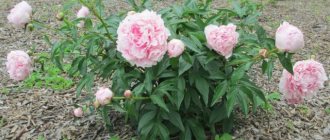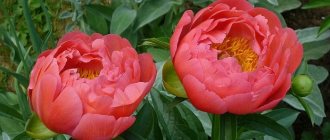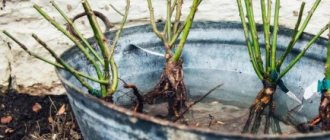Peony Coral Charm (Paeonia coral charm)
The history of the emergence of the Coral group of peonies is associated with the names of two scientists - Arthur Sanders and Sam Wissing.
If the first managed to obtain specimens with salmon and coral shades of inflorescences, then the second went further and created a whole group of such varieties, which included the Coral charm peony. The color of the petals changes from coral to milky
Attention! The group of coral peonies includes varieties not only with a coral tint of inflorescences, but also of other colors
Description of the plant
Peony Coral charm is a compact herbaceous plant 0.8-1.1 meters high. The shoots are well developed and erect. The leaves have a typical shape for peonies - trifoliate with veins. The color of the leaf blade is dark green, the surface is glossy.
The main attractiveness of the variety is the color and shape of the inflorescences. They are quite large - with a diameter of 16-21 cm. They are cup-shaped and semi-double in shape. The color of the petals as the bud opens changes from dark coral to light salmon.
On the eve of wilting, the petals may take on a milky hue and turn white around the edges. This was the reason for the appearance of the name “lacticiflora peony Coral charm”. The middle of the flower is filled with small yellow stamens. In June, active flowering begins and during this period the plant spreads a charming aroma.
This is interesting! In some Russian catalogs the plant is named incorrectly - you can find the following names: herbaceous peony Coral Charm or even peony Charm coral.
Advantages and disadvantages
The Coral Charm variety is almost perfect. It has a lot of advantages, which include:
- cold resistance;
- beauty and aroma of inflorescences;
- ease of reproduction;
- long and abundant flowering;
- good disease resistance;
- moderation in care.
The disadvantages include the following:
- demands on soil;
- need for regular feeding.
These factors can hardly be called disadvantages of this variety. All varietal peonies have similar qualities. In addition, proper preparation of the site and care of plantings will completely eliminate them.
Use in landscape design
Peonies are widely used in landscape design not only due to the beauty of the inflorescences, but also because they remain decorative until frost.
These perennials are often included in continuously flowering compositions and used to create low hedges and borders. It is good to plant peonies in the foreground in a rose garden - this allows you to extend the life of the decorative composition and decorate the bare shoots of tall varieties of roses.
Planting Coral Charm peonies as a decorative hedge
Pests and diseases
The main infections to which peonies are susceptible do not pose a threat to the milky-flowering variety Coral Charm. With proper planting and timely care, the bush practically does not get sick. Powdery mildew is observed only in the shade and on waterlogged soil. The bush is replanted and treated with Fitosporin.
If the plant is in damp soil, the root-knot nematode parasitizes the seedlings. In this case, transplantation and use of Aktara is indicated. But the measures are effective only in case of minor damage; if the spread has reached a mass scale, the peony will die. The remedy is also effective against the bronze beetle.
Read more How to propagate peonies: cuttings, dividing the bush, video
Growing a flower
To grow a healthy and beautiful plant, it is important to choose the right seedling. When purchasing planting material, you must carefully inspect it
Note! It is not recommended to buy a seedling with dried roots and signs of disease. It must have healthy and strong roots
Planting with root cuttings
Before planting a flower, you must first prepare the holes. The distance between them must be at least one meter. The depth of the seat should not be more than 5-6 cm.
The planting pit is prepared in advance, approximately three weeks before the planned planting.
Boarding time and seat selection
Experienced gardeners plant peonies in late summer - early autumn. Planting in spring is not recommended. Since peonies of this variety can grow in one place for about 10 years, the choice of site should be approached carefully and responsibly. Preference should be given to sunny and well-protected from the wind places. Also, water should not stagnate there. Flowers on the eastern side feel excellent.
How to prepare the soil and flower for planting
Experienced gardeners try to prepare the planting hole a month before planting the plant. Its diameter and depth must be at least 60 cm. As soon as the hole is ready, drainage and prepared soil mixture must be poured onto its bottom.
The soil must be fertile and not acidic. The following composition is considered the most optimal:
- one part peat;
- one part of humus;
- one part sand;
- one part clay.
Important! The top layer of soil should be no more than 25 cm
Preparing the soil for planting peony Coral Charm
Step by step landing procedure
When planting a peony, you must adhere to a certain algorithm. If the substrate has managed to settle over time, you need to add garden soil. In this case, you should not overdo it, since the buds located on top of the rhizome should be deepened from the surface of the soil by no more than 5 cm.
After deepening, the rhizome is sprinkled with soil, which is thoroughly compacted. The seedling is watered with water or a weak solution of manganese. One hole requires about 8 liters of water. The final stage is mulching the hole.
Plant care
This peony does not have too high demands on care, but, like any other ornamental flowering plant, it needs timely watering, proper fertilizing, loosening the soil and treatment against possible fungal diseases and parasitic insects.
Watering and fertilizing
Watering should be done quite often, only with warm, settled, soft water. Its quantity should not be too large, since flowers do not like overflow. The first fertilizing with complex mineral fertilizers is carried out in the spring at the very beginning of the growing season. In total, you should not feed the plant more than 3 times during the season.
Mulching and loosening
After each watering, it is recommended to hill up the flower; it will have a beneficial effect on the internal and external condition of the plant. Mulching with natural materials is also useful, as it will reduce the evaporation of liquid from the soil surface.
Preventative treatment
Despite the fact that ITO peonies have a fairly high immunity, in the spring they can be sprayed with insecticides to prevent the appearance of insect pests. Treatment with fungicides will help prevent the occurrence of diseases.
It is also important before winter, after the pruning procedure, to loosen the soil, clear it of dry leaves and burn them
Care
For feeding, it is best to use a solution of mineral fertilizer with the addition of soap or washing powder (1 teaspoon per 10 liters). It is necessary to fertilize the plant by wetting the leaves from a watering can with a sieve. The procedure begins in the second week of May and is done once a month. Experienced gardeners recommend starting this work either in the evening or in cloudy weather to avoid direct sunlight.
Water the Coral Charm peony as the soil dries out. One adult bush consumes 2-3 buckets of water. This indicator should be monitored especially carefully during the period of budding and flowering. The plant also requires increased moisture at the time of bud formation; this process usually occurs in August-September. After watering, the soil must be loosened so that the water is evenly distributed throughout the root system.
The lifespan of hybrid varieties is limited to 7-10 years. In order for the peony to continue to exist, after this period it must be divided and transplanted to a new place.
To prepare the bush for winter, it is necessary to cut off all the stems at soil level. The resulting remains are sprinkled with ash. A young plant may also require additional shelter.
Peony Coral Charm, the photo of which can be seen above, is distinguished by its extraordinary beauty. If you care for it properly, it can live quite a long time and fill the garden with delicate shades and sweet aromas each new season.
Features of care
Peonies of this herbaceous species are unpretentious and can grow in almost any soil. A place in the sun, sheltered from strong winds and drafts, will be especially successful.
Now let's talk about the features of care. Growing Coral Charm is not at all difficult, following basic recommendations:
- Constantly carry out mulching and loosening of the soil. Work on loosening the soil should be carried out with maximum care, trying not to touch the roots of the flower. To avoid the formation of a crust of earthen cover, it is better to carry out this procedure soon after watering, going deeper by 5–10 cm. For mulching, you can use grass, sawdust, husks from sunflower seeds or dry leaves. This will keep the soil moist for a long time and protect the roots from overheating in the summer sun.
- Remove weeds.
- Flowers require frequent, abundant watering, especially in hot weather. In this case, the water consumption per bush is 2–3 buckets. Dried soil at the base of the roots will indicate the need for additional watering.
- If the bushes of the plant bend to the ground under the weight of flowers, a garter is required. It is recommended to install a support next to the bush in the form of high pegs, strengthen them in the ground and tie the spreading branches of the peony to them with a rope.
- Cut off faded inflorescences.
- In autumn (mid-October), the plant is prepared for winter. After cutting all the stems to ground level, small stumps are left, which are then generously sprinkled with ash. Young plants that are going to winter for the first time need to consider additional insulation.
- Fertilize the soil.
How to plant coral peonies?
Peony is a very beautiful plant. It is not surprising that many gardeners choose it. But in order for the culture to be pleasing to the eye, you need to know how to plant peonies. Experienced flower growers advise planting peonies in the ground in early autumn. Although in some cases you can do culture at the end of August. But still, experts recommend waiting until mid-September. This period is ideal in that the buds are fully formed.
How to plant peonies correctly is described below:
- Choosing a location. It is advisable that the site is on the sunny side and protected from the wind. For example, you can plant a plant near a bush or tree. The main thing in this case is to maintain a certain distance so that the roots grow and develop freely. It is also necessary to build a barrier from the wind. Peonies should not be planted close to home. After all, the walls radiate heat. Constant overheating is destructive for a flower. A space of 1.5-2 meters must be maintained between the building and the pit.
- Land preparation. She must be fertile. To improve the composition of the soil, nutrients should be added. Peony prefers loamy soil. But heavy clay ones are not suitable. But the situation can really be corrected by adding clay in combination with humus and peat. Peaty soils are not suitable.
- Fertilizer application. Before planting a young plant, a mixture consisting of ash, potassium sulfate and superphosphate is added to the hole. Water the top with a manganese solution.
- Planting and care. Make a small mound at the bottom of the hole. A division will be placed on it. The roots should be carefully straightened. Fill the voids with soil. It is required to plant so that there are several centimeters of soil above the top bud. After planting, irrigate and mulch. For mulching, use hilled soil with spruce branches or compost.
Knowing when to replant peonies and how to carry out this procedure correctly, there is every chance of growing a beautiful shrub that will delight you with abundant flowering. Without transplantation, a peony can grow for about 8-10 years. After which the bush is divided and transferred to a new place. They are usually replanted in the fall. But some gardeners are wondering whether such an event can be held in the spring. In principle, this is not prohibited
But it is important to remember that then such bushes will not bloom in the summer. And it will be much more difficult for the plant to withstand the heat.
Therefore, replanting peonies in spring is extremely rare.
Reproduction methods
The easiest and most reliable way to propagate Coral Charm peonies is by dividing the rhizomes. This operation is performed at the end of summer or at the very beginning of autumn. Only mature bushes that are at least 7-8 years old can be divided. The rhizomes are completely dug out of the ground, washed with a stream of water and dried in air. Then, using a knife, they are divided into fragments that have independent roots and renewal buds. For disinfection, the sections are powdered with wood ash, and then parts of the rhizomes are planted in planting holes.
Before dividing the peony rhizomes, you need to rinse them well.
Important! In the first year after planting, it is better to remove the buds from the plant. This will increase the peony’s survival rate in a new location.
Growing and planting in open ground
Most often, peonies are propagated by dividing the root system. You can use both its whole parts and sections - root cuttings.
Attention! A high survival rate of root cuttings of the Coral Charm peony was noted. In order to obtain new peony specimens, an adult plant is dug up and some of the soil is carefully removed from the roots.
After this, the rhizome is washed in water and left to dry for a day. When the roots dry out and become slightly soft, divide or cut the cuttings
In order to obtain new peony specimens, an adult plant is dug up and some of the soil is carefully removed from the roots. After this, the rhizome is washed in water and left to dry for a day. When the roots dry out and become slightly soft, divide or cut the cuttings.
Preparing for landing
Before planting plants in the ground, you need to prepare for it and think through everything. This implies several important points:
- Boarding time. Rhizomes can be planted in the ground both in spring and autumn. The most favorable period is the end of September.
- Accommodation. For peonies, you should choose a closed area with fertile soil. It is permissible to place the plants in a place that is illuminated in the first half of the day, and in the second half is in light partial shade.
- Soil preparation. On heavy or clayey soil, peonies grow poorly and sometimes refuse to bloom. To increase fertility and improve soil structure, it is necessary to add rotted dry manure and sand to the site. Before planting, apply a dose of complex mineral fertilizers.
- Preparing the plant. After removing the root system from the soil, it is washed and dried. Then you need to inspect the roots and trim off damaged and too long shoots. Before planting, it is recommended to soak part of the root system or cuttings cut from it in a solution of a growth stimulator.
Proper preparation for planting is half the success. When planting in the ground, you need to show no less diligence in order to enjoy fragrant flowers next summer.
Roots are used for propagation
Landing
After all the preparatory measures have been completed, you can begin planting peonies in open ground. The process itself is carried out step by step:
- Dig holes 1/3 larger than the root system.
- Pour a layer of drainage made of broken bricks, small pebbles or expanded clay.
- Pour a mound of soil, previously mixed with compost and sand in a ratio of 2/1/1.
- The rhizome is placed, distributing root shoots over the surface (if we are talking about cuttings, they are placed at the top of the mound).
- Gently water around the perimeter of the mound.
- Seal the planting hole with the remaining soil and compact the surface.
- Repeat watering and mulch the surface around the plantings.
When planted as part of the root system in the fall, already next year the flower will actively begin to grow. Before the onset of cold weather, they are watered several more times, and then covered with spruce branches for the winter. Although the Coral Charm peony is frost-resistant, young plantings need shelter.
Attention! In the first year of growth, the plant may produce several buds. It is better to remove them to stimulate the development of the root system and the growth of the vegetative mass of the flower
Propagation by seeds
Seed propagation of peonies is relevant only in one case - to obtain a new variety or intermediate results for selection. As a rule, flowers of different varieties are used and artificial cross-pollination is carried out.
Growing peonies from seeds is not so much difficult as it takes time. You can wait for such plants to bloom only for 5-6 years of life. That is why the method of dividing the roots is a priority.
Propagation seeds are used for selection purposes
Planting and care
Growing peonies will not require a lot of time or excessive effort from you.
The most important thing is to choose the right area for peonies, because they will grow there for many years. The root system of adult plants reaches a depth of 70-90 cm, so replanting a bush that has reached 4-5 years of age is not an easy task.
Peonies prefer to grow in well-lit areas; sunlight for 5-6 hours in the morning is highly desirable. But peonies are afraid of drafts, so it would be nice if they were protected by tall bushes or trees. Do not plant peonies in low areas: the rhizomes can rot from stagnant water.
Peonies are planted and replanted in late August - early September. A week before planting peonies, they dig holes measuring 60x60x60 cm at a distance of 70-100 m from each other; a drainage layer of 20-25 cm of coarse sand, broken brick or crushed stone must be laid at the bottom of the holes. Then a layer of top dressing consisting of compost, humus, 100 g of lime, 200 g of superphosphate, 100 g of potassium sulfate, 300 g of wood ash is poured in a layer of 20-30 cm. Then the holes are filled to the top with soil mixed with compost. In a week, by the time the peonies are planted, the soil in the hole will have subsided, which will make it possible to place the peony rhizome in the hole, sprinkle it with garden soil and lightly compact the soil. Keep in mind that peonies do not tolerate deep planting: the result will be a dense green bush without flowers. If you want to wait for lush flowering from peonies, deepen the rhizome so that the upper bud is no deeper underground than 3-4 cm. In addition, in the first year after planting or transplanting, peonies do not bloom and look lethargic. It happens that peonies will not bloom the next year, but this is not a problem if the bush looks healthy - it’s just that the peony bush has not yet reached maturity.
- Caring for peonies in spring. Peonies require infrequent but plentiful watering - 2-3 buckets for each adult bush, so that the soil is wet to the depth of the roots. Plants especially need moisture in early spring, during the growth period, as well as during budding and flowering, and in August-September, when new buds are formed in peonies. After watering, it is imperative to loosen the soil around the bushes and remove weeds, if any. Make sure that when watering the water gets under the bush and not on the leaves.
- Caring for peonies in the fall, as already mentioned, is the time to plant and replant peonies. Peonies are not planted every year, and if you have no plans to propagate them this year, caring for peonies in the autumn comes down to trimming withered stems and leaves, which then need to be burned to destroy viruses, bacteria and pests that may , they settled in them. The remaining stems on the bushes should be sprinkled with ash at the rate of 2-3 handfuls per bush. That's all there is to do in the fall. Now we’ll tell you how to care for peonies in the spring.
Feeding peonies. As soon as the snow melts, the ground around the bushes is watered with a solution of potassium permanganate at the rate of 2-3 g per 10 liters of water for two peony bushes. When the shoots begin to grow, you need to fertilize the plants with ammonium nitrate at the rate of 15 g of nitrate per 10 liters of water. Starting from the second week of May, young plants are watered once a month over the leaves from a watering can with a sieve with a solution of complete mineral fertilizer in the recommended concentration. Add washing powder to the solution at the rate of 1 tablespoon per 10 liters of water - this will prevent the solution from simply flowing down the leaves into the ground. Feeding is done in the evening or on a cloudy day. During the period of budding and flowering, it is necessary to mineralize the soil with the following solution: 10 g of superphosphate, 7.5 g of ammonium nitrate, 5 g of potassium salt per 10 liters of water. Two weeks after the end of flowering, you need to feed the peonies with a solution of 10 g of superphosphate and 5 g of potassium salt per 10 liters of water. You can alternate mineral fertilizers with organic ones, and instead of a solution, scatter dry fertilizers in the furrow around the bush, followed by moistening and embedding into the soil.
Complete pruning of peony stems is done in late autumn, when frost sets in. But if there is a need to do this earlier, then try to cut the stems not too low, leaving shoots with three to four leaves above the surface of the ground. The fact is that at the end of summer, peonies lay replacement buds, and the success of this process directly depends on the presence of leaves on the bush. Therefore, by the way, when cutting flowers you need to follow this rule: cut the peduncle not very close to the root, leave a part of the stem with several leaves on the bush.
Peculiarities
Regardless of the variety, all coral peonies have common characteristics:
- Large bush size. Most varieties grow up to 70–90 cm. The plants have a spreading crown and a well-branched root system.
- Frost resistance. These peonies feel great in the Russian climate and successfully winter when the thermometer drops to –40ºC.
- Moderate solarization and watering needs. Peonies grow well in open areas that get full sun most of the day. However, excessive solar activity can be detrimental to them. The soil in the flowerbed should always be moist. At the same time, stagnation of water or flooding of the area after the snow melts can provoke diseases of the root system.
- Drained neutral soil. Peonies do not like acidic soil. The maximum permissible pH level for normal growing season is 7.0 (recommended - 6.5). The soil should allow moisture to pass through and contain a small amount of clay. On heavy soils, peony roots develop poorly, which affects the size of the plant and the quality of flowering.
Information! To loosen the soil, dig up the flower bed with the addition of sand (1 bucket per 1 m²). The soil can be deoxidized by adding slaked lime (up to 500 g/m²).
Features of cultivation
Growing peonies is not at all difficult, since they do not require special care. However, it is still necessary to follow some rules.
Choosing a place and landing
It is best to place the plant in a sunny and open area. However, there should be no drafts there, so it is best to plant it next to low bushes. In addition, the hole must be dug in advance, 10-14 days before planting. It should be 70 centimeters both deep and wide. At the very bottom you need to put a layer of drainage up to 20 centimeters. It can be gravel, crushed brick, or perlite. Then you need to put a mixture of sand, leaf humus, and peat on top. They must be taken in equal proportions. The layer should not exceed 25 centimeters.
Next, everything is filled up to half the hole with ordinary garden soil and left for two weeks.
After this time has passed, you can begin planting peonies. The bush must be placed on well-established soil. Then you need to carefully straighten all the roots so that they are evenly spaced. Sprinkle everything on top with regular substrate and compact the surface thoroughly. It is also necessary to ensure that the buds are not too deep. After this, the soil must be watered generously with either water or a manganese solution.
You can put a small layer of mulch on top, which will allow you to retain moisture longer. In addition, in this case, a huge number of weeds will not grow. Both spruce branches and regular compost can be used as mulch.
For 2 weeks after planting, you need to water the bush daily, after which watering is done as needed. In cool weather, water once every 2 weeks, and on hot days you can do this daily. Fertilizers must be applied several times per season. Peony will need both superphosphate and potassium.
Feeding should be done in early March, just before flowering, and at the end of August.
After the peonies have bloomed, they can be trimmed or left on the bush. Some gardeners leave the buds after flowering to obtain seeds. However, when grown by seed, they may not retain all of their characteristics, which is especially true for hybrid plants.
If a bush grows in one place for a long time, then its root system will not grow, so after 7-8 years it is necessary to transplant the peonies to another place.
Rules of care
Care comes down to watering and fertilizing, loosening the soil.
It is customary to feed peonies with mullein, pouring a liquid solution into circular furrows around the perimeter of the bush. Feeding of this type helps the roots develop quickly and successfully form buds for renewed growth, strong stems, and large leaves. If mullein is not available, it is replaced with mineral fertilizer dissolved in water.
Carry out regular, abundant watering twice a month, followed by loosening the soil around the bush. After flowering, it is advisable to feed the plant with phosphorus and potassium when watering.
For each adult plant you need to pour a couple of buckets of water, because you need it to reach the deepest roots
To prevent diseases, preventive spraying of the plant with chlorine copper oxide (40g per bucket) is carried out. It is enough to carry out the procedure once before and immediately after flowering. This will protect the bushes from spotting and gray rot.
After the first frost, when the leaves die, they are cut down to ground level. Earlier pruning interrupts the supply of nutrients to the storage roots.
Hybrid herbaceous coral peonies grow successfully in the Russian climate. If you follow the rules of agricultural technology, flowers will delight you with beauty, lush flowering, and an extraordinary richness of colors. Nurseries offer varieties of American selection, tested in conditions of cold, snowless winters and dry summers. For more than half a century, peonies with coral flowers have delighted all connoisseurs of beauty with their beauty.
Pest diseases
The most common diseases of peonies are gray rot, powdery mildew and cladosporiosis. Quite often, plants are attacked by aphids and ants.
Note! Ants and aphids are especially dangerous for peonies. They suck the juice from the buds, which leads to their drying out and lack of flowering.
Inflorescences suffer from diseases
At the first signs of deterioration in the appearance of the flower, it is necessary to spray not only the diseased plant, but also all neighboring ones. Treatment should also be carried out for prevention.
Peony Coral Supreme is a wonderful representative of the world of flowers. This rare and exquisite variety will not only decorate the garden, but also fill it with a magical aroma. The plant requires the most ordinary care, but its flowering will definitely delight flower lovers.
Peony Coral Charm (Paeonia Coral Charm) - what kind of variety is it
The Coral Charm peony flower captivates people and fully lives up to its name. The first hybrid with coral-colored petals was bred in 1964 thanks to the work of breeder S. Wissing.
How the milky-flowered peony Coral Charm blooms
For your information! The flower belongs to the group of semi-double perennials.
Brief description and characteristics
The main difference between the peony variety Coral Charm, as flower growers in Russia also call it, is its color. It can range from rich coral to baked milk. The flower is original and easy to care for. Grows well in temperate climates.
It stands out among all the others not only because of its unusual colors, but also because of its gigantic size. Peony Charm grows up to 120 cm in height.
The color of the bud changes depending on the stage of flowering. At first the plant is dark pink in color, in the middle of flowering it becomes soft coral with a light border, and at the end it acquires a pale pink hue.
Note! Of the entire coral series, this particular hybrid blooms later than all its relatives. The peduncles of this flower rise up to 95 cm
The leaves are medium-sized, dark green, few in number and tapering towards the top. The decorative effect of the bush remains throughout the entire season. Several large buds are formed on one peduncle, which reach 17-18 cm in diameter. Their structure is cup-shaped. The petals are semi-double to the touch, gathered in a thick center
The peduncles of this flower rise up to 95 cm. The leaves are medium-sized, dark green, not numerous and narrowed towards the top. The decorative effect of the bush remains throughout the entire season. Several large buds are formed on one peduncle, which reach 17-18 cm in diameter. Their structure is cup-shaped. The petals are semi-double to the touch and gather in a thick center.
Peony Coral Charm is a winter-hardy plant.
Herbaceous peony bud Coral Charm
Advantages and disadvantages of the variety
The main advantages of the flowers of this variety include an attractive appearance, a strong and tall stem, which allows you to not tie up the plant, as well as a decorative effect that lasts for a long time.
As for the shortcomings, this flower has practically none. The only thing that is noted is the late flowering.
Use in landscape design
There is a place for the magnificent and amazing Coral Charm peonies in absolutely any garden. Both single and group plantings look most impressive against the backdrop of a bright lawn. Ideal neighbors would be roses, clematis and phlox. Miniature mountain pines and junipers combine interestingly with peonies.
Peony Coral Charm in landscape design
Application in landscape design
Coral Charm with delicately colored flowers and bright green foliage combines harmoniously with different types of plants with darker inflorescences.
Important! The main condition when combining in a flower bed: the crops must have similar requirements for agricultural technology and soil quality.
It is not recommended to plant peonies in the shade of large trees and next to junipers, the growing season of which provides only an acidic environment. The proximity of plants with a creeping type of root is also undesirable. The peony will not have enough nutrition, and the aggressor plants will gradually push it out of the flowerbed.
The Coral Charm variety is used in the design of a garden or plot:
- For border structures.
- In mixborders with flowering and ornamental crops.
- They decorate flower beds, lawns, and garden beds.
- Included in compositions for decorating rock gardens, rockeries, and wild areas.
- Create flower beds consisting of different varieties of peonies.
Photos of the use of Coral Charm peony will help in creating the design of the territory.
For the winter, the container with peonies can be brought indoors. In spring, the plant is taken out onto the open veranda or into the garden, the main thing is that the peony is in the sun
The crown is dense, there are few flowers, the color is simply dark pink. Apparently, the seedling did not correspond to the variety, because it fully complied with all the conditions of agricultural technology
What do coral peonies look like?
Peony is a plant that belongs to the perennial class. It comes in different types: shrubby, semi-shrubby and herbaceous. The crop often has several stems. On average, the height does not exceed a meter.
Gardeners greeted the appearance of unusual coral-colored peonies with great enthusiasm, but it should be noted that coral color does not indicate a specific shade. For example, the buds of a plant may have a light orange-pink color or a darker tone. In the 60s of the twentieth century, a period of breeding varieties of coral-colored peonies began. The greatest results in this area were achieved by Canadian scientists Lyman Cousins and American Sam Wissing. They created Coral peony varieties, which later began to be in good demand among experienced and novice summer residents.
A detailed description of the Coral peony is given below:
- The root system is quite powerful.
- The leaves are trifoliate and pinnately divided. They are arranged in the following order. The color ranges from dark green to dark purple. It is extremely rare to find varieties with a bluish color. By autumn, the leaves acquire a yellow, reddish color.
- The diameter of the opened bud is from 15 to 25 centimeters. The flower has a multi-leaf, complex, star-shaped shape. The inflorescences are lush and beautiful.
- The seeds of the plant are quite large. Their shape is oval and round.
History of appearance
This variety of lovely flower belongs to the coral series created by the American Sam Wissing in the 60s. In addition to our hero, this category also includes other interspecific hybrids: Coral Supreme, Coral Sunset. By the way, the overseas beauty can also be called Coral Charm. Its appearance is due to the merit of another scientist - Arthur Sanders, who at the beginning of the 20th century was the first to achieve the emergence of interspecific hybrids with such shades of petals as pink-orange, salmon and coral. And Wissing simply continued the work started by Sanders, receiving a gold medal for his achievement in 2002.
Reproduction and planting
Herbaceous interspecific hybrids, like all their counterparts, are propagated by cuttings or by dividing the bush. The most suitable is to divide the root with 2-5 buds, which, with proper care, throw out flower stalks in the second year.
Full flowering begins in the third season. For proper development of the bush, the rhizomes should not be too large. Many renewal buds will absorb nutrition from the tubers, preventing roots from developing.
Planting in open ground occurs in August and September. It takes 30 days for the cutting to root.
The correct choice of location for such a long-lived peony is of fundamental importance. He will have to settle on the site for 7-10 years. The plant does not like shade and damp areas with standing water. Otherwise, the herbaceous perennial is unpretentious.
The pit for planting is prepared in advance. Size 60-80 cm in diameter. Instead of the selected soil, a mixture of humus, peat, clay and garden soil is poured to approximately 2/3 of the height of the pit. The upper part, where the division will be located, is filled with ordinary soil. Planting material is buried 5-7 cm for light soils, and 3-4 cm for heavy, loamy soils.
Coral Sunset in the landscape
The Coral Sunset peony bush looks great in solitary plantings because, having inherited the strength of the branches from tree-like species, it never falls apart and has a good habit.
Coral Sunset in the landscape
In addition, unlike herbaceous species, Coral Sunset has a long growing season. Even after flowering, its foliage fills the garden with bright greenery all summer, and with the onset of cold weather the leaves turn purple and the garden lights up with flames.
At the first frost, the branches and leaves are covered with silver frost, which looks very beautiful against the backdrop of dying nature. This gives the peony bush a new, albeit short-lived, life as a new art object.
In group plantings, peonies occupy a central place. In such a planting scheme, you need to give Coral Sunset a place that will have a good view from different parts of the garden.
Coral Sunset peonies are loved by florists because they look good both in group compositions and in solo bouquets.
Biological description
Perennial herbaceous plant.
Plant height is 91-120 cm. The bush is tall and durable. The leaves are narrow, dark green.
The flowers are about 18 cm in diameter, semi-double, cup-shaped, coral-pink, later coral-peach in color, the anthers are golden-yellow. The expression “coral coloring” does not indicate a strictly defined shade, just like “cherry” or “raspberry”. “Coral” is a mixture of bright pink and light orange tones in varying proportions.
The aroma is pleasant.
Mid-early flowering period. Blooms 5-7 days later than 'Coral Sunset'.
> In culture
Winter hardiness zones: 2-8.
For cultivation conditions, see: Peony lactiflora.
> Notes
How to choose the perfect place?
We recommend that you read
The longevity, decorativeness and productivity of the green pet largely depend on how well the gardener cares for this beautiful plant. The first thing you need to do to ensure that the plant pleases the eye for many years is to choose the right place to plant the shrub.
Peony Coral Charm feels comfortable in an area where fresh air constantly circulates. Ventilation helps prevent the development of dangerous diseases. In this case, you need to ensure that the plant is reliably protected from strong gusts of wind and drafts. It is better to choose a sunny place so that the peonies can bask in the warm rays. You can plant shrubs in partial shade, but if they are in the dark for more than 3 hours a day, flowering may be incomplete.
Peonies are absolutely not picky about the soil; they can grow in almost any soil. However, if you have a choice, it is better to plant them in loamy soil. Coral beauties will feel especially comfortable there. It is recommended to take care of preparing the planting site approximately 3 weeks in advance. In this case, the earth will have time to settle.
Varietal characteristics of peony Coral
Hybrids, such as Charm, Sunset and others, reach a height of 90 - 120 cm. The stems are strong, without side buds. The leaves are narrowed, dark green in color. Semi-double flowers with a diameter of 16-18 cm. Peonies are winter-hardy, differ in flowering time and brightness of color. Suitable for growing in average climate zones.
The advantages include a tall, strong stem, which allows you not to tie up the bush and use the plant in single and group plantings.
Many well-known coral varieties develop well in the middle zone and are quite suitable for our climatic conditions
The middle and early flowering periods of hybrid varieties enable gardeners to supplement existing flower arrangements with new perennial shrubs.
Tall stemmed flowers are ideal for cutting and decoration.
Flowers should be cut from no more than 1/3 of the bush. Leaves and stems are vegetative mass, a source of nutrients for buds to renew growth. Their development ensures flowering in subsequent years.
Description of the variety
The herbaceous peony belongs to the group of semi-double perennial plants. This is a meter-long bush with long strong stems of a reddish hue, dark green carved foliage of a narrowed shape, often with a purple tint. The shoots of Coral charm are so thick, fleshy and strong that the appearance of large inflorescences does not contribute to their deformation. Each stem in early June is crowned with one to three large buds.
Coral charm blooms in early June. As the buds open, they gradually change their color: the dark salmon hue turns into a rich coral-peach tone, characteristic of the inflorescence in the phase of full dissolution. The flower shape is cup-shaped, diameter is from 17 to 20 cm. The middle is distinguished by bright yellow stamens. If you look at the amazing flowers from the side, they resemble a satin sphere. This effect occurs due to the fact that all the wide petals that make up the bud are bent towards the center. In addition, their edges are equipped with light stripes. During the long flowering period, the crop emits a soft floral aroma. The petals of the fading inflorescence lose their coral color, turning into tangerine yellow due to fading in the sun.
The variety has good drought resistance, high frost resistance (does not freeze when the air temperature drops to -40ºС), therefore it is suitable for cultivation in the middle climatic zone. Peony is not susceptible to disease and rarely becomes a victim of insect pests. Coral charm cannot be called capricious.
Agrotechnical features
To place a decorative bush on a site, you should choose an open place, flooded with diffused sunlight. The plant requires protection from drafts. The American hybrid Coral Charm prefers loamy, slightly acidic soil. Before planting, the soil is enriched with humus and superphosphate, after which the substrate is moistened and mulched.
You can water the peony up to three times a month. The plant also needs periodic weeding. The soil around the flower is regularly loosened. In autumn, all shoots on Coral charm are cut off, and the resulting stump is sprinkled with ash. In the first years of a flower’s life, preference is given to foliar feeding. Adult specimens are fertilized with a mineral complex three times per season.
Flowering peony Red Charm
Flowering is lush and long lasting. If you properly care for your peony, you can extend its life.
Period of activity and rest
Flowering begins in late May - early June and lasts for about half a month. After this, the bush goes into a dormant stage.
Care during and after flowering
During flowering, it is necessary to regularly water and feed Red Charm
It is important to exclude the use of nitrogenous fertilizers, they are contraindicated for flowers
Important! During the flowering period, fertilizing is done 3 times: when the buds are just being laid, immediately when the inflorescences appear, after flowering. Flowering peony Red Charm
Flowering peony Red Charm
What to do if it doesn’t bloom, possible reasons
The main reasons that can cause a lack of flowering are the following:
- Lack of light. If the bush is initially planted incorrectly, it needs to be transplanted to a more open place. Only after this will it bloom.
- Lack of nutrients. After 2 years of life, additional fertilization of the substrate is required.
- Very deep planting of the flower. The maximum depth of the planting hole should be 50 cm.
Description
Peony is a perennial plant. All their types can be divided into several subspecies: these are herbaceous, semi-shrub and bush peonies. However, they all have a well-developed root system and dense stems, which can reach a height of up to one meter.
Peony leaves have a carved shape and a green color, which in some varieties changes over time. In some cases, you can also find bluish leaves. The flowers are most often double or semi-double and appear as large multi-colored buds. They reach 24 centimeters in diameter. The seeds of this plant are quite large, oblong or round in shape.
Varieties
Thanks to the successful and painstaking work of many breeders, a large number of varieties of this plant have been developed.
"Coral Pink"
This beautiful plant reaches 75 centimeters in height, has soft green carved leaves, as well as double flowers of a light pink hue. When opened, the bud reaches 13 centimeters in circumference. Flowering begins in June and lasts about 3 weeks. This variety is very popular among gardeners due to its beauty and compactness.
"Pink Hawaiian Coral"
This variety of peonies was bred in the 90s of the last century by American scientists. It is a perennial herbaceous plant that grows up to one meter in height. At the same time, its stems are quite dense and dotted with green carved foliage. The flowers are semi-double and large, up to 21 centimeters in diameter, with an apricot tint. Very often they are used for cutting.
Flowering begins early - in April, and lasts up to 3 weeks (maybe longer in cool weather).
"Pink Hawaiian Coral" tolerates cold well and does not require additional shelter during the frost period.
"Coral Beach"
Peony is distinguished not only by its beautiful and lush bush up to one meter in height, but also by its delicate coral color. The flower itself is small, up to 15 centimeters in diameter. The inflorescences are semi-double, with a yellow center. In their shape, the open buds are somewhat reminiscent of lotus flowers. A distinctive feature of peonies of this variety is their resistance to various temperature changes, as well as to some fungal diseases. Thanks to this, it is very popular among many summer residents.
"Fairy Coral"
This variety of peonies is an interspecific hybrid. Its appearance dates back to the last century. The bush is low, up to 70 centimeters, the stems are dense with beautiful decorative leaves. Coral semi-double buds, when opened, reach up to 15 centimeters in diameter and emit a delicate aroma.
Flowering is very early and long. In addition, this plant is not afraid of even severe frosts and tolerates drought well.
"Coral Sunset"
A very popular variety of peonies. It is compact, but the height of the plant reaches in some cases up to one meter. Semi-double buds are located on tall, erect stems, which are pink-peach in color with a hint of red coral. The leaves are green in color. Flowering begins early. "Coral Sunset" has received many awards at various exhibitions not only due to its beauty, but also for its easy care and resistance to temperature changes.
"Coral Magic"
This newly developed peony variety has wowed everyone with its colorful flowers. These are semi-double three-row buds with a very bright color that are visible from afar. They reach up to 15 centimeters in circumference and have yellow stamens in the middle. The bush is compact and low, up to 70 centimeters. The stems are erect with delicate green foliage. Flowering begins in April.
"Coral Supreme"
This hybrid plant is very rare. The bush has powerful stems that grow up to one meter in height. Its carved bright green leaves cover almost the entire bush, only the coral-salmon buds located at its very top are visible. When they open, they look like a bowl reaching up to 19 centimeters in diameter. In addition, during flowering they emit a very subtle aroma.
It begins in late April - early May and lasts up to two weeks.
"Coral and Gold"
This peony variety amazes everyone with its unusual beauty and large flowers. Already at the end of March or beginning of April, you can see double coral buds on the tops of a huge bush, up to 95 centimeters tall. When they bloom, they can be up to 21 centimeters in diameter. In addition, the flowers exude a rich, sweet aroma. The stems are decorated with green carved leaves.
Description of the best varieties of coral peonies
For most flowers, unstable pigmentation is a drawback, but not for coral peonies. Under the influence of sunlight, their petals are able to change colors and play with shades. Some varieties manage to change color up to 3 times in one season.
In addition to excellent external data, coral varieties also have more practical features. Among them it is worth noting:
- long flowering;
- recognizable aroma;
- possibility of growing in different climatic zones;
- unpretentiousness.
Information! Coral peonies were born thanks to the work of American breeders L. Cousins, S. Wissing and A. Sanders. The main period of their work falls on the 60–80s of the twentieth century.
Description of Paeonia Itoh Canary Brilliants
The Canary Brilliants peony is part of a group of elite, prestigious plants from the genus Paeonia, famous for the unique colors of its petals. The hybrid was created in 1999 by the American hybridizer R. Anderson. In 2010, Itoh Canary Brilliants was awarded the American Peony Society's Award of Landscape Merit.
Each stem of the Itoh Canary Brilliants peony bears up to 4 buds. In light partial shade, semi-double inflorescences of the Canary Diamond peony change their color during the flowering period from pinkish, soft peach to yellow shades. The bases of the petals, wavy along the edges, are colored reddish.
Note! In an open, evenly sunny growing area, the Kenery Diamond peony will be completely colored in bright peach or yellow shades. The bush blooms for about 3 weeks.
Flowers have stamens and pistils, but no pollen, so once the flower fades, no seeds are produced. In a bouquet placed in a vase with water, cut peony branches do not lose the petals of the inflorescences for 10 days. Flowers smell nice
The bush blooms for about 3 weeks. Flowers have stamens and pistils, but no pollen, so once the flower fades, no seeds are produced. In a bouquet placed in a vase with water, cut peony branches do not lose the petals of the inflorescences for 10 days. The flowers smell nice.
The bushes have a spreading, raised shape, dense branching, dense foliage, and strong peduncles. The plant as a whole looks lush and massive. The stems of the flower, up to 80 cm high, do not bend to the ground even during the period of mass bud opening.
The size and appearance of the leaf blades of the Kenery Brillint peony received from a tree-like ancestor. During the growing season and flowering, the leaves are colored a rich dark green; in August their color changes and becomes bronze-burgundy.
Note! The already faded peony ITO Canary Diamonds does not lose its decorative effect until the first frost. It is widely used to create multi-tiered mixborders, in rock gardens, linear and group landscape compositions, for single cultivation
Opened flower and bud of peony ITO-hybrid Canary Diamond
Reproduction technique
Peonies can be propagated in several ways. Some of the most popular and effective are cuttings, dividing the bush and layering.
1To propagate a shrub by cuttings, you need to use a small piece of rhizome. Choose a stem that has at least one dormant bud. The cuttings are carefully separated from the mother bush and planted immediately in open ground. If you perform this procedure in July, the young plant will have time to take root in September. The main thing is to follow the planting rules, take care of fertilizing and watering. For the winter, the delicate plant needs to be well covered.
2To propagate a peony by division, the mother bush must be dug out of the ground. This should be done carefully, trying not to injure the root system. The plant is divided into several parts
It is important to ensure that good buds remain on each cutting. Afterwards the shrubs are planted in open ground
During the period of adaptation, they need special attention.
3For propagation by layering, you need to use adult bushes. Their shoots are pressed to the ground and covered with a layer of soil. The upper part of the stem should remain on the surface. The shoot is secured with a peg and, if necessary, additional soil is added. By September, the first roots appear on the shoot. The stem is carefully cut and replanted.
It is better to choose a dry day for peonies propagation.
After transplanting young plants, it is important to take care of abundant watering.
How to care for peonies?
Growing the Coral Charm peony is quite simple. The main thing is to comply with several conditions. Necessary:
- regularly loosen and mulch the soil;
- get rid of weeds in a timely manner;
- water the bushes abundantly and regularly;
- feed the soil with fertilizers;
- tie up bushes;
- remove faded buds in a timely manner;
- properly prepare plants for the onset of winter cold.
Loosen the soil around the bush with the utmost care
It is important to ensure that the root system of the plant is not damaged in the process. You need to go no more than 10 cm into the ground
It is better to carry out the procedure after watering or rain. In this case, an earthen crust does not form. Mulching allows you to retain moisture for a long time and prevent overheating of the roots in hot weather. You can use dry grass, sawdust, and fallen leaves for it.
The peony has a great need for regular hydration. Water is especially necessary at the beginning of the season, when the bush itself and the buds on it are actively growing. The plant needs to be watered once a week
It is important to ensure that at least 35 liters of water are spent on each bush. During hot periods, additional watering may be required.
How necessary it is can be judged by the dryness of the soil around the peony.
Large spreading bushes must be tied up. If this is not done, the heavy buds will eventually bend the bush to the ground. As a result, the central part of the plant will open, and the peony runs the risk of becoming waterlogged or, conversely, drying out. All this can lead to the death of a green pet. To prevent such a development of events, you need to carefully drive wooden pegs around the bush and tie the peonies to them with a rope.
To prepare the plant for the winter season, it is necessary to remove all branches at ground level. The remains of the stems are sprinkled with ash. If a young shrub will winter in open ground for the first time, it is recommended to take care of creating additional shelter.
Peonies after flowering
As soon as the peony fades, it begins a very important life period. At this time, the plant prepares for winter and restores its strength. Therefore, the further condition and development of the plant depends on how correctly the care is organized during this period of time.
Transfer
If you plan to transplant a peony, then, according to the descriptions of this variety, autumn is considered the most favorable period. The most important thing is to carefully prepare the soil and replant the flower correctly.
Diseases, pests and ways to combat them
Peonies of this variety suffer from viral and fungal infections. Most often they are subject to the development of gray rot, rust, and mosaic. There is also a risk of powdery mildew or septoria. Fungicides help destroy fungi.
Ants really love peonies
Plants may suffer from pest attacks. Most often, ants, nematodes, and aphids cause their damage. Insecticidal preparations help to cope with parasites.
Peonies are beautiful ornamental plants that are very popular among gardeners. The Red Charm variety is considered an excellent choice for decorating your site.
Planting by seeds
Most gardeners do not use seeds to propagate Paeonia Pink Hawaiian Coral. Seedlings obtained after seed germination do not have the qualities endowed with the parent plants. But if you still have the task of growing a seedling from seeds that have a beautiful name, consonant with the Pacific coral island, then first you need to purchase high-quality seeds of these peonies and check their germination.
Then the seeds are treated with a fungicide or simple pale pink potassium permanganate, washed in running water, dried and placed in flower pots with a soil substrate of neutral acidity, buried 5 cm. This is done in August-September, approximately 30 days before the onset of cold weather. Pots are buried in the garden for the winter. The seeds need to stay in the cold, preferably under snow or mulch, for at least 2 months. In the spring, with the onset of warmth, peony seeds should germinate.
Note! In autumn, seedlings are transplanted from flower pots to a flower bed.











